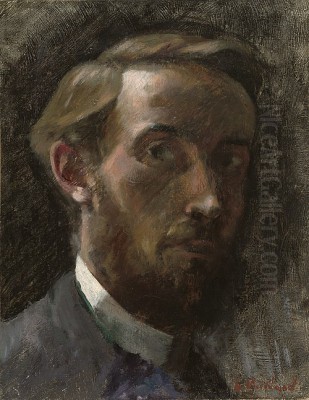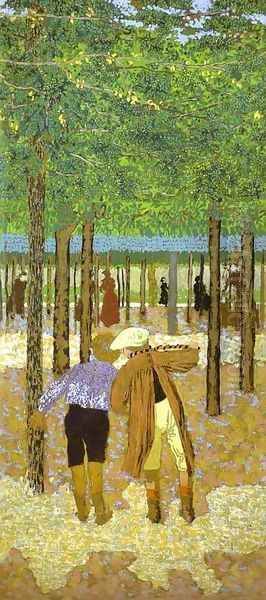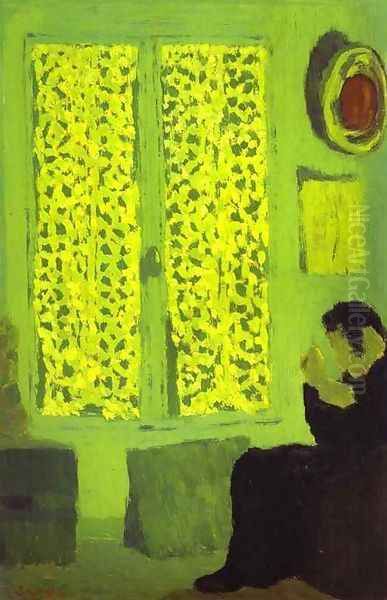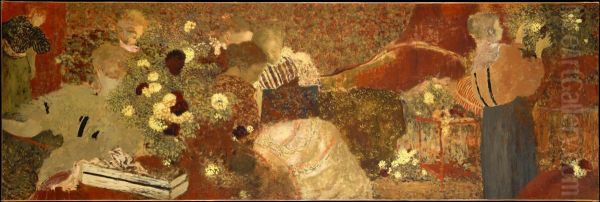Jean-Édouard Vuillard: Chronicler of Intimacy and Decorative Harmony

Jean-Édouard Vuillard (1868-1940) was a prominent French painter, printmaker, and decorative artist whose career spanned a period of significant artistic upheaval and innovation. A key figure in the Post-Impressionist movement and a founding member of the Nabis group, Vuillard is celebrated for his intimate depictions of domestic life, intricate decorative panels, and insightful portraits. His work offers a unique window into the social fabric of fin-de-siècle Paris and the evolving artistic sensibilities of the era.
Born in Cuiseaux, Saône-et-Loire, Vuillard's early life was shaped by his family background. His father was a retired naval officer, and his mother, Marie, was a skilled seamstress. This familial connection to textiles and craftsmanship would profoundly influence Vuillard's artistic vision, particularly his fascination with patterns and textures. The family moved to Paris, where Vuillard's mother established a dressmaking business. This environment, filled with fabric scraps, fashionable clients, and the bustling activity of a working home, provided the setting for many of his most iconic works.
Vuillard's formal artistic training began at the Lycée Condorcet, where he met lifelong friends and artistic collaborators, including Ker-Xavier Roussel, who would later become his brother-in-law, the musician Pierre Hermant, and the writer Pierre Veber. These friendships were crucial to his artistic development, fostering a collaborative and intellectually stimulating environment. Although he enrolled at the prestigious École des Beaux-Arts and the Académie Julian in 1886, Vuillard quickly grew disillusioned with the rigid academic curriculum. He found greater inspiration in self-directed study and the company of like-minded artists who sought to break away from traditional artistic norms.
The Nabis: Prophets of a New Aesthetic
Vuillard's artistic trajectory was fundamentally shaped by his involvement with Les Nabis, a group of young artists who emerged in the late 1880s. The Nabis, whose name means "prophets" in Hebrew, were deeply influenced by the Symbolist movement and the synthetic approach to painting advocated by Paul Gauguin. They rejected the illusionistic representation of reality in favor of expressing personal emotions and visual experiences through flattened forms, decorative patterns, and vibrant colors.

Along with Pierre Bonnard, Maurice Denis, Paul Sérusier, Félix Vallotton, Paul Ranson, Aristide Maillol, Henri-Gabriel Ibels, and Georges Lacombe, Vuillard became a central figure in this avant-garde circle. The Nabis were united by a shared philosophy that art should be integrated into everyday life, extending beyond easel painting to encompass decorative arts, illustration, printmaking, and theater design. This multidisciplinary approach resonated deeply with Vuillard, who embraced various mediums throughout his career.
Early Works and Symbolist Influences
Vuillard's early works from the late 1880s and early 1890s reflect the prevailing Symbolist aesthetic and the influence of artists like Pierre Puvis de Chavannes and Jean-Léon Gérôme. During this period, his paintings often featured flattened forms, bold outlines, and a reduced palette. He explored themes of introspection, emotion, and the mysterious aspects of everyday life.
His early works, such as "Self-portrait with Vauquelin," exhibit a sensitivity to light and shadow, hinting at the sophisticated color harmonies that would characterize his later style. The influence of Japanese woodblock prints, particularly those by artists like Utagawa Hiroshige and Kitagawa Utamaro, was also significant during this period. Vuillard was an avid collector of Japanese prints, and their emphasis on decorative patterns, asymmetrical compositions, and flattened perspectives is evident in his own work.
The Intimiste Style: Capturing Domestic Life
Perhaps the most celebrated aspect of Vuillard's oeuvre is his "intimiste" style, which flourished in the 1890s and early 1900s. This period saw him focus on small-scale, intimate depictions of domestic interiors and family scenes. His paintings from this time are characterized by rich, complex patterns, vibrant color palettes, and a keen observation of the subtle interactions between people and their surroundings.
Works like "The Piano Lesson," "Interior with a Standing Woman," and "Dinner Time" exemplify his ability to transform ordinary moments into visually compelling and emotionally resonant images. He often depicted his mother, sisters, and friends in their apartments, surrounded by their belongings, which become integral elements of the composition. The intricate patterns of wallpapers, fabrics, and carpets merge with the figures, creating a sense of visual unity and highlighting the interconnectedness of the domestic sphere.
Decorative Projects and Public Commissions
The Nabis' commitment to integrating art into daily life led Vuillard to pursue various decorative projects. He designed screens, panels, and murals for private homes, embracing the idea of art as an enhancing element within architectural spaces. One of his most famous decorative series is "Jardins Publics" (Public Gardens), created between 1894 and 1899. These large-scale panels depict women and children enjoying Parisian parks, showcasing his mastery of color and pattern on a grander scale.

Beyond private commissions, Vuillard also received significant public commissions later in his career. He painted murals for the Palais de Chaillot in Paris in 1936 and for the League of Nations building in Geneva in 1937. These large-scale works demonstrate his adaptability and ability to translate his artistic vision to different formats and contexts.
Collaboration with the Theater
Vuillard's connection to the theater was another important aspect of his artistic career. He was friends with prominent figures in the theatrical world, including the director Aurélien Lugné-Poe, for whose avant-garde Théâtre de l'Œuvre he designed sets and stage decorations. His theatrical work allowed him to explore different visual languages and experiment with color, light, and form in a dynamic setting. This collaboration with the theater underscores the Nabis' broader interest in the applied arts and their desire to break down the traditional boundaries between painting and other creative disciplines.
Transition to Realism and Portraiture
Towards the end of the 19th century and into the 20th century, Vuillard's style underwent a gradual shift. While still retaining a sensitivity to color and composition, he moved away from the more overtly decorative and flattened forms of his Nabis period towards a more realistic approach. He began to focus increasingly on portraiture, capturing the likenesses of prominent figures in Parisian society.
These later portraits, such as those of the Bernheim-Jeune family, art dealers who became his patrons and friends, are characterized by their psychological depth and attention to detail. While some critics perceived this shift as a move towards conservatism and a departure from the avant-garde, his late works reveal a continued dedication to capturing the nuances of human character and the complexities of social life. He masterfully depicted the textures of clothing, the play of light on faces, and the subtle expressions that revealed the inner lives of his sitters.
Exploring the Natural World
Although renowned for his interior scenes, Vuillard also found inspiration in the natural world. He frequently traveled to the French countryside, particularly Normandy and Brittany, to paint landscapes. These plein-air studies, while often less finished than his major works, reveal a different facet of his artistic sensibility. They are often more spontaneous and free-flowing, capturing the fleeting effects of light and atmosphere. These landscapes provide a counterpoint to his more structured interior scenes, demonstrating his versatility as an artist.
Personal Life and Enduring Relationships

Vuillard was known for his introspective and somewhat reserved personality. Described as quiet and melancholic, he preferred to observe and listen rather than dominate conversations. Despite his introverted nature, he cultivated deep and lasting friendships. His relationship with Ker-Xavier Roussel was particularly significant, influencing both their personal lives and artistic practices. The two artists often worked together and shared ideas, their friendly rivalry pushing them to explore new avenues.
His relationship with his mother was central to his life and art. After his father's death, he lived with his mother and sister, and their presence permeates many of his most famous paintings. His depictions of his mother, often shown engaged in domestic activities, are tender and insightful, revealing a profound bond. These images of women in domestic settings are not merely genre scenes; they are deeply personal reflections on family, identity, and the passage of time.
Rediscovery and Critical Acclaim
Although successful during his lifetime, Vuillard's reputation experienced fluctuations in the mid-20th century, as abstract art gained prominence. However, a major retrospective exhibition in 1936 helped to reintroduce his work to a wider audience. Since then, his art has been consistently celebrated for its unique blend of intimacy, decorative beauty, and psychological insight.
Today, Vuillard is recognized as a crucial figure in the transition from Impressionism to modern art. His influence can be seen in the works of artists who explored domestic interiors, pattern, and color in innovative ways. His ability to find beauty and significance in the ordinary, and to imbue his paintings with a sense of quiet intensity, continues to resonate with viewers worldwide.
Legacy and Artistic Impact
Jean-Édouard Vuillard's artistic legacy is multifaceted. As a founding member of the Nabis, he played a vital role in the development of Post-Impressionism and the exploration of decorative art. His "intimiste" paintings redefined the genre of domestic interior, elevating everyday scenes to the realm of fine art. His experimentation with printmaking expanded the possibilities of the medium, and his theatrical designs showcased his versatility and imaginative flair.
His influence extended beyond his immediate circle, inspiring generations of artists who sought to capture the nuances of modern life and the complexities of human relationships. His work is held in major museum collections around the world, a testament to its enduring artistic significance and its ability to connect with viewers on a deeply personal level. Vuillard's ability to blend observation with emotion, and to find harmony in the interplay of color and pattern, solidifies his position as a master of modern art.